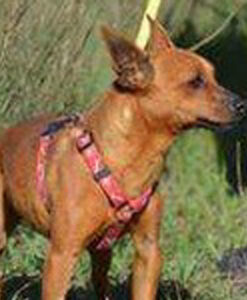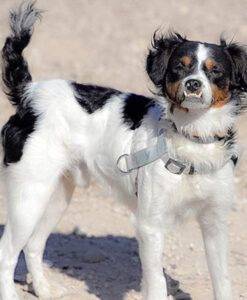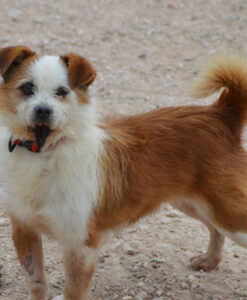Animal Care in Spain
Local Animal Diseases & Infections
When moving to Spain it is important to note that there are a number of diseases and dangers for pets that aren’t found in most other European countries. For dogs these include the fatal Canine Leishmaniasis (also called Sandfly Disease), Ehrlichiosis (also called Tick Disease), Filariasis (also know as Heartworm), and Processionary Caterpillars.
Similarly cats can be susceptible to Feline Leukaemia Virus and Feline Infectious Enteritis. Extra care must be taken when walking your dog in rural areas as hunters and poachers lay poisoned bait to control natural predators such as foxes. Also note that poisoned bait is sometimes found on urbanisations to keep down the feral cat population.
Travelling to the Mediterranean might expose your dog to a severe, often fatal disease called Canine Leishmaniasis. Leishmaniasis is a zoonotic parasitic disease transmitted through the bites of the Phlebotomine sandfly and is the third most important disease worldwide.
How Leishmaniasis is Spread?
The disease is carried from dog to dog by a microscopic parasite called Leishmania Infantum which is spread by sandfly bites. Dogs can be bitten up to 100 times an hour during the sandfly season, which in Spain begins in May and ends in September.
How the Transmission of Leishmaniasis Occurs
A sandfly bites a dog which is carrying or infected with Leishmaniasis. Later, the same sandfly bites a healthy dog and injects Leishmania with the saliva under the skin of the dog. From the site of infection the Leishmania starts a very difficult development in several steps until they reach the blood stream, and after an incubation period of between 3 weeks and 3 months (sometimes 3 years), depending on the state of the dog’s defense system, the first visible symptoms occur.
The sandfly is active between April and November (during the warm season) and disappears in winter. The sandfly hides during the daytime and comes out late afternoon with the highest period of activity occurring at night between 2:00am and 4:00am. Therefore, dogs who live outside are much more exposed to sandfly bites than dogs who live inside - especially if the house is well protected against mosquitoes with nets and chemical products.
The month of August is the most active with the highest amount of sandflies, and this is when they are most likely to invade the house where they will hide in dark bathrooms or wardrobes.
An animal infected with Leishmaniasis might exhibit the following symptoms: Skin alterations, eye alterations, weight loss, long growth of nails, swollen lymph glands, liver and kidney disease (including failure), alterations in blood coagulation with anemia, nose bleeding, lameness, or chronic diarrhea.
Treatment of Leishmaniasis in a dog is only effective if begun at an early stage of the infection, therefore it is very important to make regular blood tests in dogs once a year, often in the winter months to determine whether the animal was infected during the preceeding summer. Early treatment normally avoids symptoms and gives the dog a longer life.
Dogs with mild symptoms can be treated successfully as well, but dogs with serious anemia or serious alteration of liver / kidney function very often cannot be treated successfully. There is no vaccination against Leishmaniasis.
Prevention of Leishmaniasis
It is very difficult to prevent Leishmaniasis completely because sandflies are so very tiny they can even penetrate mosquito netting, but there are 3 key points to help avoid risk of infection:
- Dogs should be kept inside at night to reduce exposure to sandfly bites.
- Provide your dog with a special anti-sandfly collar which is proven to be more effective than other insecticides. Start in March with the collar application and maintain it until the end of November (ask your vet for an X-Spot or Scalibor collar).
- A yearly blood test to make sure your dog has not contracted this disease.
Ticks hide in well watered gardens and in the bushes and shrubbery of the fields, especially in areas frequented by passing sheep and goats. This is where dogs collect ticks. The female tick of the Rhipicephalus can be a "carrier" of tick disease, she can carry bacteria of the species "Rickettsia", known as Ehrlichia Canis in her saliva. Whilst sucking blood from the dog, the tick can infect the dog with Ehrlichia. After a variable incubation period, Ehrlichia reach certain white blood cells (moncytes) which flow in the blood stream and can infect the whole body.
Prevention of Ehrlchiosis
After every walk, examine your dog for ticks. If you find ticks, remove them immediately, the longer the tick sucks blood the more likely is a following infection with tick disease. Ask your vet how to remove a tick correctly. In regions where there is a big tick problem, the dog should be protected with special repellent, anti-tick collars or liquids, ask your veterinarian for advice.
If you find a tick fixed in your own skin, remove it immediately with alcohol (pharmaceutical grade, not gin) and a clockwise turning movement. NEVER PULL. Then consult your vet.
Symptoms and Diagnosis of Ehrlchiosis
A general check in conjunction with a blood test is the best way to determine Ehrlichiosis:
- Sudden haemorrhaging (bleeding from the nose, the mouth, or subcutaneous bleeding)
- High fever and complete weakness
- Eye and nose discharge
- Loss of appetite
- Loss of weight
- Serious anemia
Treatment of Ehrlchiosis
In the early stages, the application of a dedicated antibiotic for 10-14 days. In some dogs who have a weak defense system, symptoms can appear so violently that the animal needs intensive care with blood transfusions. If the disease is not detected in time, the animal may die.
Filariasis is commonly known as Heartworm Disease. It is caused by a roundworm parasite which breeds inside the arterial vessels of the host. Transmission occurs from mosquito bites. A lot of mosquito species are carriers of infectious stages of the heartworm.
Main victims that are infected are dogs, and it is unusual for cats to contract it. Heartworm disease is a "summer disease" as it goes together with mosquito bites. The main season in Spain is April until October. Female mosquitoes transmit infectious stages of Dirofilaria in the skin of the canine host.
From the site of the infection, the small dirofilaria larvae start a subcutaneous migration of several weeks until they reach the circulation which carries them to their main breeding place, the right heart chamber and the main lung artery. By this time the parasites are starting to cause serious damage to the dog's circulation system. They cause a bloodstream blockage as they live in the right heart chamber and the main lung artery and in advanced cases these problems lead to heart failure and sudden death.
Prevention of Filariasis
Prevention is far better than treatment in this case, and application of the annual Guardian vaccination is recommended. Prevention is very easy and saves the dog a lot of problems. There are several preparations on the market, either topical or oral treatment which is applied once a month (ask your vet) between April and October. They kill the infectious worm stages immediately after the mosquito bite, thus avoiding consequent problems.
Symptoms of Filariasis
Several months after infection, clinical symptoms occur:
- Chronic cough
- Loss of energy
- Shortness of breath with the lightest of exercise
- Fever
- Expectoration of blood
- Anemia
- Swelling of the hind legs
- Ascites (water in the abdominal cave)
- Altered liver and kidney blood values, and in severe cases a life threatening heart insufficiency.
Diagnosis and Treatment of Filariasis
A microscopic examination of the patient´s blood sample often shows living worms. If no worms are found, a serologic test will give a safe and definite diagnosis.
The success of treatment depends upon the stage of infection. Treatment before the appearance of heart insufficiency or oedema is easy and successful. It comprises of two injections against the adult worms and a consecutive oral treatment against the larvae which infect the blood stream.
Advanced cases are more difficult to treat and may require the surgical removal of the worms in the heart and lungs, followed by the complete rest of the dog for one month with special anticoagulant therapy followed by the application of anti-heartworm therapy.
Pine Processionary Caterpillars are so called because they form processions, nose to tail, as they leave the nest prior to changing into moths. They are found in all Mediterranean climatic areas. The "nests" are fist sized or larger balls of spun filaments usually lodged in fairly high branches of pine trees.
The months from October through to March and April see the time when the caterpillars descend from the cocoon nests and they will then form processions in search of soft, warm earth in which to pupate. There can be hundreds of caterpillars nose to tail, winding along roadways, paths, or grass. The caterpillars have poisonous and irritant brittle hairs on their bodies, and are a mottled dull brown with faded yellowish splotches.
For dogs and cats, the problem is that the caterpillars have an attractive bittersweet smell and taste and both dogs and cats will try to eat them. The results are almost certainly fatal and as little as three will kill a medium sized dog. Just one may produce death in a feline. The reaction to the poison also causes necrosis of the tongue, and by the time the owner notices the problem, it is usually too late for effective veterinary treatment except ease suffering.
Do not brush a procession away as this can cause more problems than it solves, spreading the irritation-producing hairs and thus the risk of poisoning actually becomes higher as a result. Instead, keep your cats and dogs away from processions until they pass, keeping animals indoors and out of reach of the caterpillars.
This is a very dangerous virus with worldwide distribution and very advanced in the Costa Blanca, Spain. The Feline Leukaemia Virus causes a "slow virus infection", in other words it has a long incubation period before the first symptoms occur.
It affects the lymphopoietic system of the body and the bone marrow. Symptoms can be very unspecific like weight loss, swelling of the lymph glands and general depression. It can also cause liver or kidney swelling or a tumor of the thyme in the chest. A blood test very often shows tumorous white blood cells, but sometimes they disappear from the blood and an antibody test is needed to diagnose the disease.
Treatment of FeLV consist of chemotherapy (similar to leukemia in humans), but life expectancy is not long. It is much better to prevent leukemia in cats as the virus is identified and an effective vaccination exists. Prevention is safe and consists of a yearly vaccination. Contact your local vets clinic for more details.
This virus is distributed worldwide. Often referred to as "Cat AIDS" because the symptoms resemble human AIDS, however no relationship between human AIDS and FIV has been demonstrated. As its name says, this virus reduces the effectiveness of the cat's immune system exposing the cat to any unspecific infection without the normal function of its biological defense system.
Symptoms are very unspecific like general depression, recurrent high fever, recurrent flu infections, skin infections and after a certain time depending on the cats condition - death. Very often the FIV virus prepares the way for other virus infections such as Feline Leukemia. This combination is fatal for the cat in a short time. There is no existing vaccination, and this virus is the most threatening infection today for our domestic felines.










